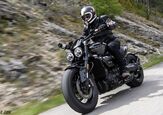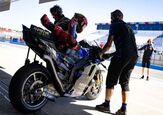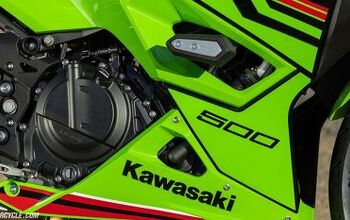Church Of MO: First Impression: 1997 Kawasaki ZX-7R

A look back at one of the best motorcycles Kawasaki ever made.
One of the best motorcycles Kawasaki ever made? To me it is – and I've never ridden one. But I grew up watching legends of Pro Roadracing like Doug Chandler, Anthony Gobert, and Eric Bostrom, among many others, hustle the Kawasaki ZX-7R to the top step of the podium. Many times in races where it had no business being on top. To stumble upon this quick ride of the 1997 ZX-7R – in the hands of accomplished racer Shawn Higbee, no less – was a real treat to read. We hope you enjoy this flashback in time, too.
Kawasaki's ZX-7R is a perfect example of motorcycle engineering refinement. In 1993 Kawasaki designed the new generation ZX-7R that has, to this day, remained virtually unchanged. For 1997 Kawasaki continued to refine rather than redesign. It's hard to argue against this approach as it is obviously working on the racetrack. Doug Chandler's performance on the Muzzy Superbike is proof enough that this machine is extremely competent.
The lack of obvious design changes or a new appearance may make it hard for dealership salesmen to make their pitch, but knowledgeable consumers will recognize the ZX-7R as an impeccable package needing no sales hype.
The ZX-7R benefits from having any annoying initial design flaws solved over its four years of steady refinement. This makes for a pleasant ride with little to complain about. Some of the issues Kawasaki addressed over the years were unusable mirrors and providing an ergonomically correct cockpit.
One of the first things you'll notice when riding the '97 ZX is that its mirrors are practical, allowing you a broader view than just your shoulders. Its cockpit feels smaller and more compact than on early models, with subtle comfort changes like adjustable levers to suit a wide range of hand sizes that previously were unavailable.
Kawasaki's preference towards racers is evident with the 1997 ZX-7R. Chandler and Muzzy seemed to have influenced the changes, shaping it into a precision piece. Its chassis is very well behaved, never doing anything other than what's instructed. Pushing the ZX hard in the canyons rewards the rider. Predictable steering is unmistakable due to its 25 degrees of rake and 3.9 inches of trail.
The combination of larger than average trail numbers and peculiarly narrow triple clamps require a heavy push on its handlebars to turn the bike quickly, while the triangulated profile of the Dunlop tires complements the bike's geometry perfectly, allowing it to reach maximum lean angle quickly and effortlessly. Although initial input is heavy, once leaned over the handling is neutral and the profile effect of the tires is very noticeable. Compared to early models, the new ZX-7 has better throttle response and midrange acceleration. The main reason for these improvements is the reduction of the intake ports by 4mm.
"Smaller ports allow for better intake velocity and fuel atomization."
The increased velocity pulls a better signal at the carburetor's needle jet, allowing for excellent carbonation. Other improvements over the original formula include Muzzy's touches in the form of a strengthened crankshaft, two springs per valve, and a special baffle in the joint pipe to maximize exhaust pulse effect for more torque. Low and mid torque was improved with a balance pipe connected between the number one and number four header pipes. The head itself was refined with straighter ports, aiming the 38mm carbs at 50 degrees into the combustion chamber.
Kawasaki has now fitted the ZX's transmission with involuted splines on the input and output shafts, allowing for less backlash. Suspension components are also fully adjustable in the front and rear and control the chassis' attitude well. Adjustments include compression, rebound and ride height.
An experienced rider may now raise the rear to reduce front rake for quicker steering, and its firm ride still will soak up the big bumps. Those interested in commuting may choose to loosen the suspension settings for more comfort around town. I would recommend adjusting the factory settings by reducing front rebound two clicks, and dialing-in one less click of rebound and 3mm less preload on the rear.
Brakes were improved for '97 by changing from four-piston calipers to six-piston, with the result being increased feel and power. New brake pad material also contributes to Grade-A stopping performance. The initial bite isn't there, but a strong hand increases stopping power with its rising rate. Improved from the original 1993-spec machine is the appearance and sound of its exhaust system. The sleek-looking pipe has a deep, powerful tone -- louder than most stock pipes. Minimal restriction allows the engine to breathe yet it still remains quieter than an aftermarket muffler.
"Among the most noticeable changes in the new ZX-7R is the addition of another ram air duct in the front fairing. Kawasaki's ram induction system is one of best designed. A noticeable increase in acceleration is felt during top speed runs."
From a distance, the 1997 ZX-7R doesn't look different, but its refinements will be noticed in real-world riding. It feels small -- like a heavy 600cc bike, but with noticeably more low-end grunt and a little more top-end. The power delivery is one of the most linear I've ever sampled, and its spot-on carburetion, instant throttle response, and impeccable chassis manners make the ZX-7R a very logical buy.
Specifications:
Manufacturer: KawasakiModel: 1997 ZX-7RPrice: 99.00Engine: Four-stroke, DOHC, liquid-cooled, 16-valve inline fourBore and Stroke: 73 by 44.7mmDisplacement: 748ccCarburetion: Four Keihin CVKD38Transmission: 6-speedWheelbase: 56.5 inchesSeat Height: 31.1 inchesFuel Capacity: 4.8 galClaimed Dry Weight: 448 lbs
Become a Motorcycle.com insider. Get the latest motorcycle news first by subscribing to our newsletter here.

Troy's been riding motorcycles and writing about them since 2006, getting his start at Rider Magazine. From there, he moved to Sport Rider Magazine before finally landing at Motorcycle.com in 2011. A lifelong gearhead who didn't fully immerse himself in motorcycles until his teenage years, Troy's interests have always been in technology, performance, and going fast. Naturally, racing was the perfect avenue to combine all three. Troy has been racing nearly as long as he's been riding and has competed at the AMA national level. He's also won multiple club races throughout the country, culminating in a Utah Sport Bike Association championship in 2011. He has been invited as a guest instructor for the Yamaha Champions Riding School, and when he's not out riding, he's either wrenching on bikes or watching MotoGP.
More by Troy Siahaan



































Comments
Join the conversation
I love this test, brings back so many memories. I had bought a ‘97 Euro spec, red-purple Kawasaki ZX-7R when this test came out so I was particularly pleased that my beloved MO liked it. I ended up selling that bike to buy another Kawasaki, a ‘00 ZX-6R. I never forgot about my 7R however so I bought another one -same color- in 2019. I modified it this time, Andriani fork internals (set up by HK Suspension in Netherlands), Hyperpro fully adjustable shock, Brembo RCS brake and clutch master cylinders, adjustable clip-ons (for a much more comfortable but still sporty seating position). It rides beautifully and looks great as well so it’s a keeper this time…